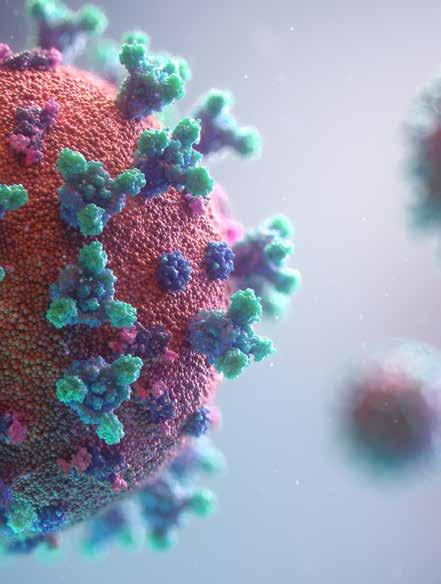
4 minute read
SAFETY & MAINTENANCE
Vaccination Guidelines
America’s COViD-19 Vaccination Campaign Allows For Reduced Restrictions
The Centers for Disease Control and Prevention (CDC) issued its first set of recommendations on activities that people who are fully vaccinated against COVID-19 can safely resume.
The new guidance—which is based on the latest science — includes recommendations for how and when a fully vaccinated individual can visit with other people who are fully vaccinated and with other people who are not vaccinated. This guidance represents a first step toward returning to everyday activities in our communities. CDC will update these recommendations as more people are vaccinated, rates of COVID-19 in the community change, and additional scientific evidence becomes available.
“We know that people want to get vaccinated so they can get back to doing the things they enjoy with the people they love,” said CDC Director Rochelle P. Walensky, MD, MPH. “There are some activities that fully vaccinated people can begin to resume now in their own homes. Everyone – even those who are vaccinated – should continue with all mitigation strategies when in public settings. As the science evolves and more people get vaccinated, we will continue to provide more guidance to help fully vaccinated people safely resume more activities.” » Visit with other fully vaccinated people indoors without wearing masks or staying 6 feet apart. » Visit with unvaccinated people from one other household indoors without wearing masks or staying 6 feet apart if everyone in the other household is at low risk for severe disease. » Refrain from quarantine and testing if they do not have symptoms of COVID-19 after contact with someone who has COVID-19.
A person is considered fully vaccinated two weeks after receiving the last required dose of vaccine. Although vaccinations are accelerating, CDC estimates that just 9.2 percent of the U.S. population has been fully vaccinated with a COVID-19 vaccine that the FDA has authorized for emergency use.

While the new guidance is a positive step, the vast majority of people need to be fully vaccinated before COVID-19 precautions can be lifted broadly. Until then, it is important that everyone continues to adhere to public health mitigation measures to protect the large number of people who remain unvaccinated.
CDC recommends that fully vaccinated people continue to take these COVID-19 precautions when in public, when visiting with unvaccinated people from multiple other households, and when around unvaccinated people who are at high risk of getting severely ill from COVID-19: » Wear a well-fitted mask. » Stay at least 6 feet from people you do not live with. » Avoid medium- and large-sized in-person gatherings. » Get tested if experiencing COVID-19 symptoms. » Follow guidance issued by individual employers. » Follow CDC and health department travel requirements and recommendations.
In Observance of One-Year Pandemic Milestone
By: Rochelle P. Walensky, MD, MPH, CDC Director
One year ago today, the World Health Organization declared COVID-19 a global pandemic. The toll of this disease and the continued loss of life around the world and in our nation is heartbreaking. To so many of you who have felt the pain and loss of a loved one during this pandemic – you have suffered the ultimate loss, and we grieve with you.
After a year of this fight, we are tired, we are lonely, we are impatient. There have been too many missed family gatherings, too many lost milestones and opportunities, too many sacrifices. And still, through it all, there is determination; there are stories of giving and hope, of stamina and perseverance. We are better together, and together, we will endure.
The vaccination of millions every day gives me hope. Hope that we can beat this pandemic. And hope that we can get back to being with our family, friends, and community. And soon.
Earlier this week, CDC released our first evidencebased guidance for fully vaccinated people. These new recommendations are a first step in our process of returning to everyday activities – safely spending time with family and friends, hugging our grandparents and grandchildren, and celebrating birthdays and holidays.
While we accumulate more evidence to support the safe return to everyday activities, please continue taking precautions in public and when around people who are at high risk for severe COVID-19 disease. Whether you are already vaccinated or not yet vaccinated, wear a well-fitted mask, practice physical distancing, wash your hands often, avoid medium and large gatherings, and avoid travel. We know these measures work to prevent the spread of this virus and help protect each other.
This pandemic will end. And, our public health work will continue. Through the near-blinding spotlight of this crisis, we now clearly see what we should have addressed before– the long-standing inequities that prevent us from achieving optimal health for all. We see the impact of years of neglect of our public health infrastructure. We see the critical need for data that move faster than disease, to prevent rather than react. To move past this pandemic, we must resolutely face these challenges head on and fully embrace the innovations, the new partnerships, and the resilience of our communities that have emerged from this crisis. It is the only way we can turn tragedy and sorrow into lasting progress and improved health for all.
In one year, we have lost over 520,000 Americans to COVID-19. These are grandparents, parents, and children. They are siblings, friends, and neighbors. They are our loved ones and our community. We join together to grieve these losses and intensify our efforts so they were not in vain. I thank you for your perseverance and for your unity of mission. Together, our strength and hope will guide us to the end of this pandemic.





